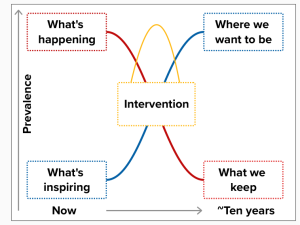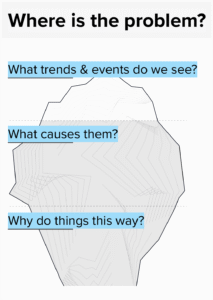Digital
Refreshing Scotland’s Digital Strategy, part 3: Using co-design in stakeholder engagement
July 23, 2025 by deborahamzil No Comments | Category Digital Scotland, Digital Strategy for Scotland, Scotland's Digital Strategy, The Scottish Approach to Service Design, user design
Blog post by Sam Hill, Senior User Researcher in Scottish Government’s Digital Directorate.
I’m a user researcher. This is a profession that specialises in running processes of learning together, testing things out, before reflecting on how well those changes went, or might go if we were to implement them. The Scottish Approach to Service Design is a good introduction to what we do.
Last autumn, colleagues working on the Digital Strategy for Scotland asked our design team in Digital Services to pitch ideas for how we might engage stakeholders in a more meaningful way. ‘Meaningful’ in that stakeholders should feel heard and supported to contribute in a way the strategy team can easily act on.
A useful lens on strategy is as a ‘complex’ problem. I mean this in a technical sense, that it involves:
- Unclear options – i.e. uncertainty on the range of workable options that are available
- Unclear choice – i.e. little agreement on what should be done
This lens gives those of us in public & stakeholder engagement a precise task:
“how might we manage these two aspects such that we realise the right vision in the right way?”
One way might be by understanding the variety of barriers getting in the way, then developing an approach that lifts these barriers for as many individuals involved as possible i.e. purposefully and thoughtfully test what the strategy is doing or what it might do against the diverse & conflicting needs of individuals in the real world.
You can understand more about the rationale behind this way of thinking by looking into fields like contemporary complexity science, systems practices (like ‘portfolio’ approaches), and design theory. There’s also a significant and rapidly growing body of empirical evidence from organisations like the Observatory for Public Sector Innovation that governments are achieving more for their publics by being intentional about reflection, creativity, and facilitating collaboration.
How we approached refreshing engagement
Between December 2024 and February this year, our design team immersed ourselves in Digital policy: reviewing literature and speaking to experts across government.
Then we designed a survey for Local and Scottish Government stakeholders which would allow them to reflect on 2021’s Digital Strategy for Scotland. They considered the barriers they faced in their daily work when pursuing its goals, what they felt enables them, and described opportunities they saw for improvement.
The responses provided more context-specific insight and a basis for discussion which we hoped would resonate with participants. In short, the survey enabled us to have participants set the agenda.
All of this was summarised under ‘the situation’ on a ‘three horizons’ framework. We displayed large canvasses on the walls around each workshop venue and asked participants to wander around, critiquing them, and developing a shared understanding in the room for the four policy areas covered by the strategy – Digital Inclusion; Digital Economy; Digital Education and Skills; Digital Public Services (see fig 1).
Figure 1: an image of a three horizons framework
The objective of the workshop was to see what that middle wave (‘the intervention’) could and should be from our stakeholders’ perspectives. We thought if the right variety of people think about and then detail how we go from ‘the situation’ to ‘the vision’, we’d begin the refresh process with a rough but immediately usable understanding of the directions of travel most enabling to stakeholders.
After getting everyone (quite literally) on the same page, we gave participants systems thinking tools like causal layered analysis, and supported them in using them to figure out what sorts of root causes might lie under the barriers summarised in ‘the situation’.
Figure 2: an image of a root cause analysis tool
Participants then looked at different roles local & national governments in the UK often play in effecting change: e.g. as a convenor, a regulator, a steward, etc. Participants contributed statements describing how different roles might take certain actions to address the ‘root causes’ they had identified earlier.
Later that day we revisited these ‘opportunity statements’ participants had contributed to the three horizons canvasses, and groups then worked together to develop and refine these into more developed proposal canvasses detailing ‘the intervention’.
Reflections
The final step of the project for our team was summarising what we heard for everyone involved. If we return to those aspects of complex problems – agreement and choice – it was good to see our co-designers respond to that summary with a lot of discussion around how to move in the directions their proposals from the workshops had in common, and little disagreement over the direction of travel.
Our team’s involvement in refreshing the National Digital Strategy was about exploring new ways to facilitate collaboration, as opposed to simply co-operating, or co-ordinating, activity across the strategy. The productive conflict between evidence, ideas, approaches, interests, and constraints that characterise real collaboration can feel uncomfortable, but by experimenting with process design, visualisation and systems thinking I think we can keep getting better at designing with our stakeholders so they can navigate complexity alongside us.
If you’re interested in finding out more about user-centred design or our work on the strategy refresh please reach out to us at DigitalStrategy@gov.scot.
Scottish Government’s Digital Directorate, COSLA and Digital Office for Scottish Local Government are working together to refresh our joint Digital Strategy for Scotland.
Tags: digital, digital public services, Digital Scotland, Scottish Approach to Service Design, scottish government, user research



Leave a comment